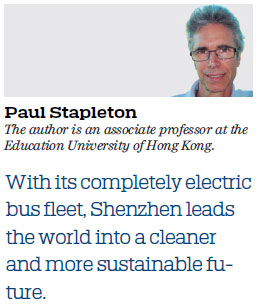HK can learn from Shenzhen in fight against air pollution
Updated: 2019-04-09 08:21
By Paul Stapleton(HK Edition)
|
|||||||
Much has been made about the poor quality of our air here in Hong Kong; however, when the issue is raised, it is often coupled with the complaint that a significant portion of the pollutants arrive from north of the boundary. And while there is certainly some truth to this claim, Hong Kong has to take some responsibility for causing its own air pollution. The daily traffic jams with fume-emitting vehicles stand as just one of the many local contributors. The fact that the number of vehicle registrations has grown by over 100,000 in the past six years to the present number in excess of 600,000 is a reminder that vehicular pollution is unlikely to disappear soon.
One partial solution to the pollution problem is electric vehicles, which don't emit any fumes, at least not from the tailpipe. Taking the lead in this area is Shenzhen. Presently, the bus fleet there is entirely electric with over 16,000 buses moving through the city without even a puff of those nasty emissions filled with tiny particulate matter and nitrogen dioxide, which our buses here in Hong Kong expose us to.

With its completely electric bus fleet, Shenzhen leads the world into a cleaner and more sustainable future. And while fossil fuels are still the primary fuel at source for powering these buses, the movement toward no-emission mass transit makes sense because those source fuels can shift to non-polluting nuclear fuel or other renewable sources in the future. In the meantime, at least roadside pollutants are minimized. Of course, Shenzhen managed their shift to electric buses because of massive government subsidies.
Back here in Hong Kong, the authorities have chosen to take a different direction concerning electric vehicles. Instead of moving toward a policy that benefits the masses, the government, in its latest budget, has decided to devote resources to expanding the number of electric charging stations to serve private e-cars around town. On the surface, such a move appears to show good intentions toward sustainability. However, in an era of increasing concern over climate change, it's bewildering that our government has chosen to give a leg up to the elites' preferred transport mode which has a much larger per capita footprint than the hoi polloi's more economical mass transport means.
Hong Kong has a world-class public transportation system, and despite recent disruptions on the MTR, the variety and speed with which one can get from point A to B in this city on public transport, has few parallels around the world. The question then is: Why is the government supporting the growth of private e-vehicles via an expanded network of electric chargers? This question becomes particularly poignant when one considers that the majority of e-vehicles presently in Hong Kong fit into the luxury category. Thus, by subsidizing the expansion of electric chargers, the government is encouraging those with the means, all 11,000 e-car owners, to lug themselves around town, mostly alone, in 2-ton vehicles. Further, this policy encourages the most inefficient use of our finite public roadways, which are getting more congested by the day.
Sadly enough, the HK$120 million that the government took from its massive reserves and surplus to increase the number of electric chargers was the closest among all its planned expenditures in the budget devoted to an environmental issue.
In the government's defense, switching to an all-electric fleet of buses has challenges. The present token fleet of 36 electric buses in Hong Kong are all single deckers because double-decker electric buses were unavailable. However, this is no longer the case; London plans to convert its whole fleet of double-decker buses to electric by 2020. Is there any reason why Hong Kong cannot follows suit?
Admittedly, one local problem is the severely constrained space for parking buses: Many chargers would have to be installed to charge buses in the off-hours. However, surely if the government can find space to expand the network of chargers for cars, they can make moves toward doing likewise for buses.
If both of these measures are still viewed as too difficult, at the very least, why isn't the government using that HK$120 million to accelerate the conversion of buses and other vehicles to Euro VI standards?
If nothing else, the government should be inviting transport officials in Shenzhen who would be happy to advise their counterparts here on how to overcome the challenges of bus fleet conversion.
(HK Edition 04/09/2019 page8)